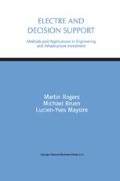Abstract
A decision model strives to represent reality in a rational, logical, coherent and purposeful way. Its primary purpose, in the context of civil and environmental engineering, is to predict the consequences of proposed infrastructure projects. The output from the model can then be used to influence the opinions and decisions of the relevant actors. It is a tool used by the decision-makers to help achieve common set of agreed goals and objectives. It can thus be termed a construct. The model (or construct) in question may be the property of an individual, a group of individuals, a wider community such as the inhabitants of a major city or the general scientific community.
Access this chapter
Tax calculation will be finalised at checkout
Purchases are for personal use only
Preview
Unable to display preview. Download preview PDF.
References
Bana e Costa, C. and Vansnick, J.C. (1997) ‘Applications of the MACBETH Approach in the Framework of an Additive Aggregation Model’. Journal ofMulticriteria Decision Analysis, 6: 2, pp 107–114.
Maystre, L.Y. and Bollinger, D. (1999) Aide a la Negotiation Multicritere: Pratique et Conseils. Presses Polytechniques et Universitaires Romandes.
OECD (1994) Environmental Indicators/Indicateurs de l’Environnement. Organisation for Economic Co-operation and Development.
Pictet, J, Maystre, L.Y. and Simos, J. (1994) “SURMESURE: An Instrument for Representation and Interpretation of ELECTRE and PROMETHEE Method Results”, in Paruccini (ed), Applying Multiple Criteria Aid for Decision toEnvironmental Management, Kluwer Academic Publishers, Collection “Eurocourses”, Dordrecht, pp. 291–304.
Rogers, M.G. and Bruen, M.P. (1995). “Non-Monetary Based Decision-Aid Techniques in EIA — An Overview”. Proceedings of the Institution of Civil Engineers, Municipal Engineer, Vol. 109, pp 98–103, June.
Rogers M.G., and Bruen, M.P. (1998) “Qualitatively Assessed Criteria within Outranking methods”. Stream Title - Qualitative assessment within MCDA, Session MD, EURO XVI, 16 th European Conference on Operational Research, Brussels, 12th to 15th July.
Saaty, T. (1980) The Analytic Hierarchy Process. McGraw Hill.
Rights and permissions
Copyright information
© 2000 Springer Science+Business Media New York
About this chapter
Cite this chapter
Rogers, M., Bruen, M., Maystre, LY. (2000). New Ideas and Techniques within Decision Aid. In: ELECTRE and Decision Support. Springer, Boston, MA. https://doi.org/10.1007/978-1-4757-5057-7_8
Download citation
DOI: https://doi.org/10.1007/978-1-4757-5057-7_8
Publisher Name: Springer, Boston, MA
Print ISBN: 978-1-4419-5108-3
Online ISBN: 978-1-4757-5057-7
eBook Packages: Springer Book Archive

